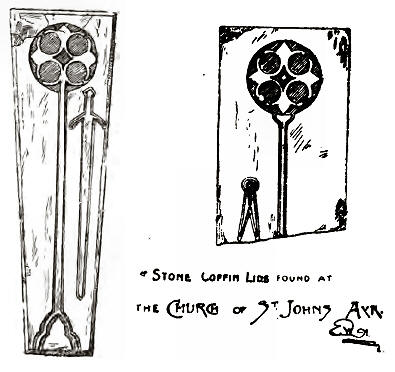
IT was Miss Boyd of
Penkill who first drew my attention to the fact that the oldest
tombstones in this district had merely a sword to indicate a man, and a
pair of scissors to indicate a woman. And she supported this by adding
that there was such a stone to be seen in the Churchyard of Old Dailly.
I ventured to remark at the time that perhaps the drawing represented a
Cross rather than a sword: but my supposition has been shown to be
groundless by the recent discovery of several stone coffins in the
burying-ground of old St. John's Church, Ayr, on which both the cross
and the sword are carved as represented above.
Certainly, the fact of a
sword being considered the emblem of a man throws a strong side-light on
the manners and customs of an age when, as one of Miss Boyd's own
ancestors remarked, "to be without the knowledge and practice of arms
was only to be half a man." While the scissors, as emblematic of a
woman, represents an age when women were more satisfied than they are
now to preside over the private concerns of the Home Department. The
scissors here represented are somewhat primitive in appearance, and
similar to what used to be called "Weaver's shears"; while the sword is
just as devoid of grace of form. But there is this to be said, that the
scissors are at least not out of harmony with the Cross by their side;
while it is somewhat hard to reconcile the sword with the mission of
Him, one of whose main objects in dying was to bring Peace on Earth.
Taking this primitive
form of Epitaph as belonging, at the latest, to the fifteenth century,
the next most ancient form in our district brings us down to the
sixteenth century, of which we possess, at least, two specimens. The
oldest is in Kirkmichael Churchyard, and reads as follows:—

In the next century (the
seventeenth) the same forms of stone and lettering were continued, but
towards the close of it, small upright slabs were introduced with sunk
letters, instead of raised ones, and it was stones of this pattern that
"Old Mortality" hewed, and which indeed were the only ones at that time
possible among the poor. Tombstones of this pattern are common enough in
our old churchyards, and one of them in Girvan reads thus:—"In memory of
Fergus M'Alexander, minister of the Gospel at Bar, who dyed Feberuar 15,
1689. His age, 73." This man was the first Protestant minister of Barr,
was "outed" along with the other ministers of Carrick in 1662, survived
the Covenanting persecution, and was restored to his old parish again,
when the dark days were over.
In the next century (the
eighteenth) the days of florid Epitaphs began, when no bad people died,
and everybody was lauded to the skies. This was the age, too, when the
backs of tombstones were utilised for allegorical drawings of Death, the
Fall, men ploughing, ships sailing, &c. This was the time, too, when
home-made poetry was in the ascendant, when every Covenanting martyr had
his laureate, and people made it a pastime to write metrical Epitaphs on
each other. Of these I shall only quote two, both connected with
Kirkoswald, and I don't quote them for imitation, but simply as
indicative of the manners of the time.
Ah me! I gravel am and
dust,
And to the grave descend I must;
A painted piece of living clay,
Man, be not proud of thy short day.
The next was composed for
himself by a Sadducee of Kirkoswald village, whose descendants, however,
sensibly refused to have it inscribed.
The man who did this stone
erect,
To Death has paid his Kane;
If his opinion be correct,
He's ne'er to rise again,
Unless the sexton wi' his shools
Shall turn him up among the mools.
The present century is
returning to the simplicity and Christian tone which characterized the
Epitaphs of the Roman Catacombs. Verses of poetry have given place now
to simple words of Scripture, and fulsome eulogies to a bare statement
of name and date. And what more is needed ? We shall all be forgotten in
a few years, and the friends who survive us won't need to be reminded of
our virtues. I confess, however, I like to see something characteristic
even on a tombstone, and I still remember with pleasure the two lines,
chosen by himself, which concludes the epitaph of William Carey, the
first English Missionary to India, in Serampore Cemetery—
"A wretched, poor, and
helpless worm,
On Thy kind arms I fall."
And in Grange Cemetery,
Edinburgh, I was pleased to observe that Alexander Duff, the great Free
Church Missionary to India, had sunk all difference of churches in these
words on his tombstone:—"First Missionary of the Church of Scotland:'

